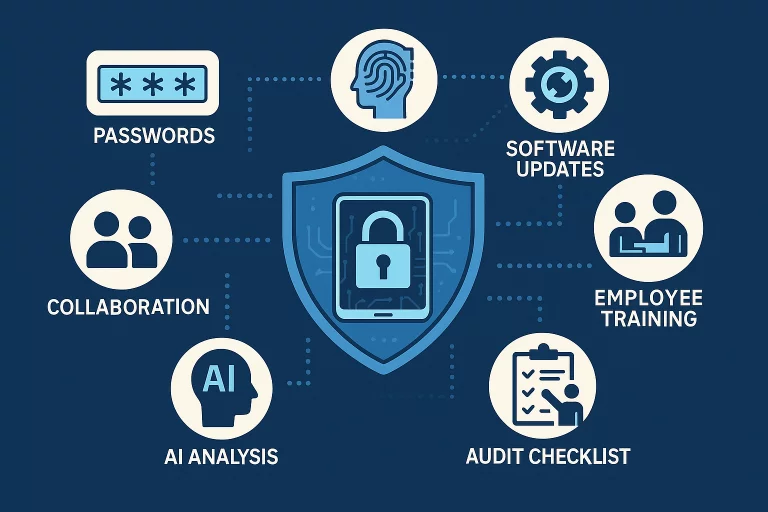Table of Contents
- Introduction
- Implementing Multi-Factor Authentication
- Utilizing Strong Passwords and Managers
- Regular Software Updates and Patch Management
- Employee Training and Awareness
- Conducting Regular Security Audits
- Developing Incident Response Plans
- Leveraging Artificial Intelligence in Cybersecurity
- Collaborating with External Experts
Protecting your digital environment today requires a robust, multi-layered strategy that considers the ever-evolving nature of cyber threats. Both organizations and individuals operate in a digital landscape where attackers are constantly upgrading their methods and seeking new vulnerabilities to exploit. As such, digital safety is no longer just a technical issue; it’s a holistic challenge that spans technology, policy, human behavior, and organizational culture. The stakes are high, with sensitive data and critical infrastructure at risk, making proactive security practices crucial for effective defense. Leveraging cybersecurity risk assessment services is one of the most effective ways to assess your organization’s security stance, as these evaluations help identify unseen vulnerabilities long before attackers can weaponize them. Implementing risk assessment, sound security habits, cutting-edge technology, and workforce education can create a more resilient approach to digital safety. This reduces risk and supports a secure digital culture. Implementing these strategies protects against data breaches and reputational damage and enhances confidence among stakeholders. As cyber incidents become more common, a proactive foundation is crucial. This framework helps organizations maintain operational continuity and resilience.
Implementing Multi-Factor Authentication
Multi-Factor Authentication (MFA) is a crucial security measure in today’s threat landscape. It requires users to provide at least two distinct forms of identification, such as a password, mobile device, or biometric measure, before accessing an account or system. This multi-layered verification reduces the likelihood of unauthorized access, even if primary credentials are compromised. Implementation can range from simple SMS codes to advanced biometric scans and hardware-based security keys. As emphasized by the World Economic Forum, organizations that deploy MFA see significantly fewer successful account takeovers. In today’s environment, where cyberattacks target users of all technical skill levels, integrating MFA into every access point should be viewed as non-negotiable—an absolute necessity for anyone committed to protecting confidential information.
Utilizing Strong Passwords and Managers
Ensuring every user account has a strong, unique password is a core tenet of digital hygiene. Weak or reused passwords are a leading cause of breaches since cybercriminals rely on tactics like credential stuffing and brute-force attacks to access accounts. Creating long, random passwords for every service is impractical without a digital tool to help manage them. Password managers address this issue by generating and securely storing complex passwords inside an encrypted vault, eliminating users needing to memorize dozens of logins. By instituting organization-wide policies that mandate password managers, companies can virtually eliminate the risks posed by password reuse and weak credentials. Additionally, these tools can be integrated with browsers and devices for seamless use, making security convenient rather than burdensome. Organizations and individuals can dramatically lower the likelihood of account compromise simply by adopting password managers into their daily routine and security policies.
Regular Software Updates and Patch Management
Software vulnerabilities are continuously discovered—even in trusted and widely used operating systems and applications. Attackers closely monitor software updates and exploit patches that have not been applied, making unpatched systems a prime target for cyber incidents. Establishing a routine for regular software updates and dedicated patch management is one of the simplest yet most effective ways to reduce your attack surface. Automated update mechanisms ensure that critical vulnerabilities are addressed immediately, while manual checks and testing procedures help organizations assess the stability and security impact of new software updates. Companies should prioritize patching software according to the risk posed by each vulnerability and be proactive about monitoring software vendors’ security advisories. This diligence prevents threat actors from taking advantage of known vulnerabilities, protecting systems and sensitive data from costly breaches often resulting from outdated software.
Employee Training and Awareness
Technology alone cannot protect against every cyber threat; human vigilance and awareness play an equally significant role in any security strategy. End users are frequently the first line of defense, and the most common entry point for attackers using social engineering tactics like phishing, pretexting, and baiting. Comprehensive, ongoing security training programs arm employees with the knowledge to detect suspicious activity, recognize social engineering cues, and respond appropriately to attempted compromises. Interactive training sessions, simulated phishing campaigns, and up-to-date materials on current scam tactics ensure staff remain alert and informed. Human error is implicated in 95% of successful cyberattacks—a sobering statistic that affirms the urgent need for regular awareness sessions. Periodic reinforcement of security protocols curbs risky behaviors and cultivates a culture of security consciousness throughout the organization.
Conducting Regular Security Audits
Routine security audits are critical for maintaining a healthy digital infrastructure and uncovering hidden vulnerabilities that may have developed over time. These thorough assessments involve analyzing system configurations, reviewing user permissions and access levels, checking firewall and network settings, and inspecting compliance with industry standards and regulations. Security audits also consider the practical enforcement of existing policies and highlight discrepancies that might compromise the organization’s security posture. External audits add further value by bringing objectivity and specialized expertise that in-house teams may lack due to routine or operational bias. Remediating issues found in audits strengthens defenses and helps organizations avoid regulatory penalties and reputational damage resulting from preventable security lapses. Audits are an essential form of accountability that drive continual improvement of security measures and ensure that organizations are resilient against evolving threats.

Developing Incident Response Plans
A well-structured Incident Response Plan (IRP) is crucial for minimizing the impact and duration of a cyberattack. An effective IRP clearly outlines roles, responsibilities, and communication channels for all response team members. It should detail actionable steps for detecting, containing, eradicating, and recovering from various types of incidents, whether from malware outbreaks, data breaches, or system compromises. Regularly simulating incident scenarios with tabletop exercises enables organizations to evaluate their readiness, clarify decision-making processes, and uncover areas for improvement. The goal is to ensure a swift and coordinated response that limits damage to assets, preserves evidence for legal or regulatory reasons, and maintains business continuity. In the digital age, every organization should treat its IRP with the same gravity as fire safety procedures—preparation is not optional, as incidents are a matter of “when,” not “if.”
Leveraging Artificial Intelligence in Cybersecurity
Artificial Intelligence (AI) and Machine Learning (ML) rapidly redefine cybersecurity by automating threat detection and response. AI-powered systems can monitor massive volumes of data, recognize abnormal patterns of behavior, and spot threats far sooner than manual methods or signature-based tools could. These intelligent systems learn and adapt quickly, catching new, previously unseen attack methods that traditional security controls might miss entirely. AI streamlines security operations by prioritizing alerts, automating routine tasks, and helping teams focus on complex investigations rather than repetitive chores. As digital infrastructures expand and become more complex, integrating AI-based security solutions ensures that organizations remain agile and responsive to new threats. This approach enables proactive threat hunting, early breach detection, and efficient response—qualities increasingly essential in a resilient, modern cybersecurity program.
Collaborating with External Experts
The rapid evolution of cyber threats and regulatory demands makes it nearly impossible for most organizations to stay fully protected, relying solely on in-house resources. Partnering with external cybersecurity experts—specialized consultants, managed security service providers. and penetration testers—opens access to the latest intelligence. advanced technologies, and industry best practices. These experts conduct thorough risk assessments, simulate sophisticated attacks, and provide actionable recommendations to strengthen defenses and close skill gaps. Additionally, external partners are invaluable in helping organizations achieve regulatory compliance, conduct digital forensic investigations, and plan for recovery after an incident. Organizations create a flexible and adaptive approach to managing risk and safeguarding their environment by engaging with outside experts and leveraging their insights. Collaboration ensures digital safety becomes an ongoing. organization-wide priority rather than a one-time project.
By adopting these layered, proactive measures and continually evaluating your security posture, you can defend against current and emerging threats. Whether you are an individual or running an organization, maintaining a resilient digital presence requires vigilance, adaptability,

